| Article ID | Journal | Published Year | Pages | File Type |
|---|---|---|---|---|
| 8915870 | Engineering Geology | 2018 | 32 Pages |
Abstract
The Newmark sliding block model is widely used in the evaluation of seismic slope stability. When using this model, the horizontal acceleration is usually considered to act parallel to the slope (downslope), and the vertical component of ground motions is commonly ignored. This study investigates the effect of vertical accelerations on the results of sliding displacement, and quantitatively compares the difference of the displacement DN calculated from the original Newmark's approach with the displacement DHV calculated from a more realistic case (horizontal and vertical accelerations properly considered). For this purpose, 4136 ground motion recordings are selected from the NGA-West2 database, and >2000 hypothetic slopes are simulated with critical accelerations ac ranging from 0 to 0.8â¯g. Comparison of DHV and DH shows that the incorporation of vertical accelerations only slightly increases the displacement. Besides, the calculated  DHV/DN ratios are generally in the range of 1 to 5, indicating that DN significantly underestimates the slope displacement due to the simplification of seismic excitations. The  DHV/DN ratios generally increase as ac increases. Simple predictive models are proposed to quantify the correction factor KD (KDâ¯=â¯DHV/DN). They can be easily used in seismic landslide hazard assessment to improve the performance of the original Newmark's approach.
Related Topics
Physical Sciences and Engineering
Earth and Planetary Sciences
Geotechnical Engineering and Engineering Geology
Authors
Wenqi Du,
